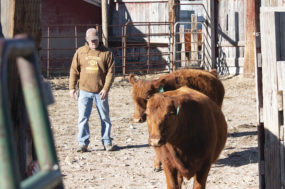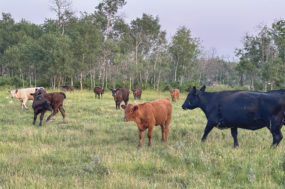Single-step refers to the incorporation of genomic data in the form of genotypes, along with pedigree and phenotypes, into a genetic evaluation to produce expected progeny differences (EPDs). This differs from the way genomic data were historically incorporated into EPDs. In the past, breed associations either used a correlated trait approach or blending.
In both of these cases, marker effects were estimated in a training set, evaluated in another set of animals, and the resulting prediction equation was applied to newly genotyped animals. This was the process used to calculate the Molecular Breeding Value (MBV) that was then either fitted in multiple-trait models (correlated trait approach) or blended together with the traditional, pedigree-based EPD to create a genomic-enhanced (GE)-EPD.
The benefit of having moved to a single-step implementation for genomic selection is it results in a more accurate accounting for the influence of genomic data on the resulting EPD. Research has shown that single-step methods reduce the bias observed using the two historical MBV-based approaches mentioned above.
Currently, two general statistical methods for single-step evaluations are used. One is single-step genomic best linear unbiased prediction (ssGBLUP) and the other is a super hybrid model (sHybrid). The former is currently employed by Angus Genetics Inc. (Angus and Charolais evaluations) and several American breeds (Santa Gertrudis Breeders International, Beefmaster Breeders United, International Brangus Breeders Association) utilizing software from the University of Georgia, and the latter is implemented by the American Hereford Association (AHA) and International Genetics Solutions (IGS) with the BOLT software from Theta Solutions LLC.
BOLT is simply software that implements a specific type of model. In the case of IGS and AHA, the general model implemented is sHybrid. The hybrid model, as implemented, selects approximately 2,500 SNPs estimated to be the most informative from the full 50K assay and then uses only this selected subset in the genetic evaluation, allowing for some markers to have more influence on the genetic merit estimates of animals compared to other markers.
As beef breed associations implemented these changes, they also changed other components of their genetic evaluations, including updates to genetic parameters (e.g., heritability), changes to economic selection indices (e.g., AHA) and changes to the statistical models used to estimate EPDs for several traits. In the case of multi-breed evaluations (IGS), changes were made to the way breed effects are estimated.
Below are some key changes made in addition to the change to single-step incorporation of genomic data.
Numerically lower accuracy
For breeds using the BOLT software (AHA, IGS), the accuracy values associated with EPDs will go down in many cases. This seems counterintuitive given that the EPDs are actually more reliable. Lower accuracies occur because the methods previously used to approximate accuracy led to overestimates, and the new method to calculate accuracy provides more accurate values (think of it as more accurate accuracy).
Stayability (IGS)
IGS has published a multi-breed stayability via single-step for over a year. However, it is important to realize there are differences between the “new” and “old” stayability EPD. The new improved version uses a model that enables more data to enter the genetic evaluation and defines contemporary groups in a more sensible way. This leads to re-ranking of animals, but also to more accurate estimates of the genetic potential for the most economically relevant trait of importance to producers who retain replacement heifers.
Sustained Cow Fertility (AHA)
A new EPD for AHA that is very similar to Stayability discussed above.
Carcass
The carcass EPDs take advantage of true carcass data, ultrasound data and growth traits measured early in life. The addition of growth traits measured earlier in life to the carcass models has been made to multiple breed associations’ genetic evaluations to mitigate the issue of bias from sequential culling (culling only the “bad” animals that later have carcass data).
Weekly genetic evaluations
Breeds that have implemented single-step evaluations using BOLT now publish updated EPDs weekly.
Breed effects
Given IGS performs a multi-breed evaluation, there was a need to correctly adjust phenotypic records for breed effects, and for the effects of heterosis with the goal of allowing the resulting EPD to be directly comparable across breeds. This also produces EPDs that estimate only the additive genetic merit (i.e., heritable component) of an animal as a parent. Currently, IGS estimates breed differences for most traits from their multi-breed database. The exception to this approach is for carcass traits. In this case, the breed effect estimates for carcass traits are obtained from the U.S. Meat Animal Research Center’s Germplasm Evaluation Project.
The benefit of having made the transition to a BOLT-enabled evaluation is principally the ability to estimate EPDs on a weekly basis for entire breed associations using complex statistical models. The results show that accuracy of EPDs have improved. Depending on the breed, genotyping a non-parent bull adds as much accuracy as if the bull had produced eight to 24 offspring for growth traits and up to 25 offspring for a trait like stayability.
There is a continued need for more records in order to continuously improve the genetic evaluation of beef cattle. Breeders can help by submitting carcass data and female fertility records; this will improve accuracy of the EPDs for these two suites of traits.
Additionally, animals with records for these traits should also be genotyped. Genetic evaluations for several beef breeds currently suffer from a general lack of genotypes on female animals. Consequently, genomic predictions for sex-limited traits become problematic. And yet another reminder, even in the era of genomic selection, phenotypes (observed performance records) are still king, and producers must not stop or limit phenotypic data collection. ![]()

-
Matt Spangler
- Beef Genetics
- Extension Specialist - University of Nebraska – Lincoln
- Email Matt Spangler








